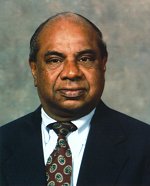

EAC Focus - N. RadhakrishnanDirector of the Information Technology Laboratory, U.S. Army Engineer Waterways Experiment Station |
N. Radhakrishnan (Radha) has been involved in leading-edge engineering and information technology for more than three decades. During the early days of finite element modeling, he became one of the principal users of computers to conduct research in this area. "Many of us who started out as large users of computer time during the late 1960s became leaders in the move toward computational science and engineering," he says. "The field has maintained its rapid pace of technological advances and innovation-- something that has kept my interest over the last 30 years."
Radha earned his B.S. in civil engineering from Madras University, Madras, India; his M.S. in civil engineering from the Indian Institute of Technology in Bombay; and his Ph.D. in civil engineering from the University of Texas at Austin. He joined the U.S. Army Engineer Waterways Experiment Station (WES) in 1969. The facility is the largest civil and environmental engineering research & development operation in the U.S. Radha currently serves as Director of the Information Technology Laboratory (ITL), one of five laboratories at WES.
As ITL Director, Radha manages a budget of more than $100 million per year and more than 250 government and 150 contract employees. ITL's main research thrusts are in interdisciplinary engineering computer applications, computer science, information technology, and instrumentation design. Radha's research is primarily focused on soil-structure interaction, finite elements, computational engineering, and Computer-Aided Engineering.
Some of the facilities housed at ITL include the first of four DoD High Performance Computing Major Shared Resource Centers, the Tri-Service CADD/GIS Technology Center, the largest of two U.S. Army Corps of Engineers Regional Business Processing Centers, the Corps' Software Technology Center, the leading Scientific Visualization Center in the federal government, and an advanced techology mini-laboratory.
The founder of ITL, Radha says, "Early on, I was fortunate to recognize the importance of interdisciplinary teams that combined computational scientists with subject matter experts. While this is considered standard protocol today, 25 years ago this was novel. Today, the strength of my organization is anchored by an environment in which cross-disciplinary teams are taken for granted and operate seamlessly on a variety of projects."
Throughout his career, Radha has conducted numerous conferences, specialty meetings, colloquiums, and short courses. He is an active member of the American Society of Civil Engineers (ASCE) and several other national organizations and committees. Among his numerous honors and awards are the ASCE Computing in Civil Engineering Award (1997), the Federation of Government Information Processing Councils' John J. Franke Professional Service Award (1997 and 1993), the Government Computer News Agency Award for Excellence (1994), the General Services Administration's Interagency Committee on Information Resources Management Award for Executive Excellence (1994), and inclusion in Federal Computer Week magazine's Federal 100 (1996 and 1993). In 1991, Radha was recognized by Engineering News Record for one of the outstanding contributions that year to the construction industry--the first-ever standards for a computer-integrated approach to all Corps construction projects. Radha is a recipient of the Exceptional Civilian Service Award (1978) and the Meritorious Civilian Service Award (1991) from the Department of the Army. He received the WES Director's Award for Excellence in Equal Employment Opportunity (EEO) in 1997, 1995, and 1988.
A member of the CRPC EAC since 1997, Radha says, "The CRPC has been a pioneer in recognizing the need to achieve improved abstraction in our programming models, leveraging cross-disciplinary teams, and collaborating substantially between their geographically distibuted team. The EAC provides the necessary continuing dialogue with senior members from our community to ensure that the CRPC pursues an agenda of national significance."